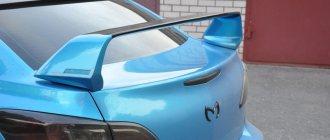On September 28, Russia celebrates Mechanical Engineering Day. The machine builders closest and most understandable to us work at AvtoVAZ. On the occasion of the holiday, “Another City” will tell about their wildest fantasies.
Text: Andrey Kochetkov
Over almost half a century of its existence, AvtoVAZ has developed many prototypes, concept cars, and cars that simply did not reach mass production. Some of them can now be seen in the AvtoVAZ Technical Museum in Tolyatti. Some now exist only in photographs. When you admire some of them, it becomes a pity that they did not go into series. And you won’t be able to take a closer look at them somewhere in a traffic jam on the Moscow Highway. Some models are amazing. After contemplating some of them, you want to lose yourself in the chaos of revelry on the Day. Some ideas were quite straightforwardly borrowed from foreign colleagues. Some were the fruits of their own Tolyatti imagination. In a word, this not the most famous part of AvtoVAZ’s developments looks as contradictory and ambiguous as the model range that went into series.
Representatives of which can be found on the roads of almost the entire planet. In honor of Mechanical Engineer's Day, we have selected 10 of the most interesting developments of AvtoVAZ, which you will never accidentally catch your eye.
VAZ-E1101
This cute dwarf, Tyrion Lannister from Game of Thrones, from the auto industry was born at the end of 1972. In the era when the “troika” was the last innovative development of “VAZ”, put into production. And the production of the Soviet tetralogy of cartoons about Cheburashka has not yet crossed the equator.
In fact, the alternative experimental version of the “penny” at the plant was named after the then-new cartoon character. The idea of a compact front-wheel drive car began back in 1968. As our own development, which is an alternative to the Fiat twins, whose mass production lasted at VAZ for another four decades. “Another Kopek”, made from scratch using semi-handicraft methods, remained a prototype forever. It could not compete with Fiat’s developments and did not go onto the production line. For example, a cute dwarf was passing gas into the cabin.
However, it was with “Cheburashka” that AvtoVAZ began its long thorny journey to develop its own car models that were not borrowed from overseas.
VAZ-1151 Gnome
The experimental VAZ-1151 Gnome was shown at the Moscow Motor Show in 1991. The subcompact urban hatchback had a simplified design and four passenger seats, taking into account the fact that the two in the front were for adults, and the two in the back were truncated for children. The total weight of the VAZ-1151 Gnome was only 490 kilograms. The car was designed on the basis of Oka components and components. A two-cylinder carburetor power unit, developing 30 horsepower, was borrowed from it.
It was assumed that the VAZ-1151 Gnome would be put into mass production, but the project was never implemented due to a lack of funds. The car plant simply ran out of investments. As a result, the VAZ-1151 Gnome remained a concept car. Today it can be seen in the AvtoVAZ museum in Tolyatti. Subsequently, on the basis of the VAZ-1151 Gnome, the experimental electric car VAZ-1152 “Elf” was designed.
VAZ-2122 "River"
The most famous Soviet jeep “Niva” is currently considered in the world almost the main achievement of the domestic automobile industry. It’s not for nothing that it has been produced and sold for almost three decades; it’s time to consider it synonymous with “stability.” And it seems that the domestic jeep will still dance a jig on our graves.
Not surprisingly, there are several variations on the theme of the Soviet SUV. Some of them are quite exotic. VAZ-2122, nicknamed “River”, is the first and last amphibian created in Tolyatti. A car that moves by rotating its own wheels both on land and on water has never been mass-produced.
It’s a pity... The shoals of “Rivers” plowing the Volga distances with the Zhiguli Mountains as a background excite the imagination.
VAZ-1801 “Pony”
Like many Soviet technical developments, the VAZ-1801 is a fantasy about the products of the capitalist world. In 1969, the British Mini Moke arrived at VAZ, in which the chief designer drove the breeze around the plant.
After about 10 years, the plant developed its own version of the Briton. It was an electric car with two batteries, the charge of which was enough for 110-120 kilometers. The design of the appearance of the model, codenamed “Pony,” was carried out by the creator of the Oka exterior.
The Soviet electric car was supposed to be launched for the Moscow Olympics. But they didn’t have time to finish it on time. And then it was forgotten, having previously appeared at several automobile exhibitions. Which is no wonder... Why did the USSR need a golf cart? At that moment, the country was more interested in cars that would be convenient for transporting pumpkins from the countryside.
VAZ-21073
One of the modifications of the “Seven”, created in the year of Kuibyshev’s 400th anniversary. Crazy fantasy on the Volvo design theme. In fact, this is an attempt to combine the “seven” and the details of the upcoming “eight”. Now the words “seven” and “eight” are more associated with Californian Windows and iOS. And then it was more about ours, the Volga...
VAZ-21073, by and large, was a design pampering. Because at that moment the best forces of the plant were already thrown into the serial launch of the Lada Sputnik.
LADA RAPAN
This miracle came to earth as if from a dream of Luc Besson who had had too much. The car is named after a predatory mollusk brought from the Far East to the Black Sea and which has currently devoured almost all the small fauna there. Rapan is an electric car, shown in 1998 after 12 long years of development. The car, whose controls are hidden in the steering wheel, was met with great curiosity at the Paris Motor Show. But this was just a case of “about seeing Paris and dying.”
AvtoVAZ wanted to attract RAO UES of Russia so that the holding would equip existing conventional gas stations with Rapanov charging devices. But in the diocese of Anatolia Chubais the idea did not cause delight. And the only “Rapan” in the world now stands in the hall of the AvtoVAZ management, and Tesla electric cars from Silicon Valley drive on the roads of the world.
Developments of Soviet engineers that never went into mass production
In the Soviet Union, as in other countries producing cars, along with mass production, a great many conceptual car models were created. Some were made for competitions, others were created in an attempt to introduce new technologies into the auto industry .
Over the years, very promising models were developed at automobile factories in the USSR. Today we will talk about unknown Soviet cars that never reached motorists.
NAMI Luaz "Proto". In 1989, this car was positioned as a 4-seater SUV. It consisted of a steel frame, which was covered with removable panels. The seats were folded out so that a large bed was obtained, which occupied almost the entire salon.
NAMI 0288 "Compact". This car was assembled in 1988 in a single copy and was supposed to be the first Soviet mini. Its maximum possible speed was 150 km/h with a gasoline consumption of 6 l/100 km. The on-board computer was responsible for the operation of the suspension. At the 1989 Tokyo Motor Show, the Compact took 5th place among 30 concept cars presented. However, the collapse of the Soviet Union did not allow the car to go into mass production.
ZIS 112. The legendary Buick X90Na inspired the designer to create this car. But the ZIS 112 had its own special style. Its length was almost 6 m and its weight was almost 3 tons, so it was not suitable for participation in circuit racing and was sent for revision.
"Ohta." It was assumed that this car would be roomy and comfortable, with the ability to comfortably transport 7 people. The salon had the possibility of transformation, in which the front seats turned 180 degrees, and the middle row turned into a table. The headlights were built into the front bumper, from under which a spoiler extended at high speeds.
ZIL-4102. The ZIL plant acquired the Rolls Royce Silver Spirit for study and the possibility of subsequently designing a luxury car. This is how ZIL-4102 was released. Only 2 copies of the car were produced. Each was equipped with a V-shaped 8-cylinder engine and a modern sound system with 10 speakers, and the ability to play not only radio, but also CDs. But M.S. Gorbachev did not like the car and the development was closed.
VAZ-2702 "Pony". This car was created as an electric truck. It was a collection of engineering solutions - from an ethyl alcohol heater to an aluminum frame made of pipes. But the first tests revealed many problems - a strong smell of alcohol in the car interior, spontaneous opening of the windows while driving, low frame strength and unreliable brakes. The car was sent for revision, but it also failed subsequent tests.
ZIL-118 “Youth”. The car had a high-quality interior trim and moved quite smoothly. In 1967 At the bus exhibition in Nice, he received 17 awards. But it was not sent into mass production, since serial production involved too much expense. Several times afterwards the car was produced on special orders from the KGB, television and for the work of the ambulance service.
GAZ-24-95 "Volga" Experienced. Only 5 all-wheel drive vehicles were rolled off the assembly line in 1974. Their important difference was the lack of a frame. One of the five copies served L.I. Brezhnev at his hunting estate Zavidovo, while the rest were given to the military and police for testing. The car was never put into mass production due to the high cost of the project and uncertainty about the high demand for this model.
In conclusion , I would like to say that all we know about the Soviet automobile industry is that many cars were borrowed from foreign companies, but, nevertheless, the Soviet Union had enough of its own competent designers and many of its own interesting developments. Unfortunately, many were never destined to go into mass production, but they became part of the history of our automobile industry.
LADA OKA-2
A small car of a new generation of domestic production, which is so lacking on our congested roads, was even produced at AvtoVAZ. But they made Oka-2 in the mid-2000s, only 10 of them. And something went wrong...
KamAZ and SeAZ were interested in the new Oka. Yuri Luzhkov wanted to launch its production at the idle facilities of ZIL. But all these plans turned into decay. And now Oka-2, like the Yo-mobile, has become a beautiful but sad page in the history of our automotive industry.
VAZ-2120 “Nadezhda”
The first domestically produced minivan was made at the experimental production of Avtovaz from 1998 to 2006. They managed to make as many as 8,000 “Nadezhda” products. But domestic consumers did not feel much faith or love for them. They were called obsolete and unreasonably expensive.
The quote “gives the impression of a car assembled from spare parts from different models” says almost everything about Nadezhda.
However, the “twenties” also have their fans. Like everything made on the basis of Niva.
VAZ-2120 Utiliter
The original van, which was planned for release in 2000. Engineers equipped the VAZ-2120 Utility with a high roof and solid body sides. The cabin is separated from the cargo compartment by a protective partition. The van's carrying capacity is 530 kilograms of cargo.
What do you think about these experimental models that did not make it into mass production? Write comments and follow our news.
LADA-2151
A concept also shown at the Moscow Motor Show in 2002. Such cars, according to the ideas of their creators, were supposed to replace the VAZ “classics”.
At first we plan to call the car “Strezhen”. But this name was cut down because the Russian letter “Zh” was inconvenient for promotion on the world market. As a result, the 51st Lada was called “Neoclassic”. But the “ecological niche” of “Neoclassics” in the model line. And the 51st remained just a rather successful fantasy of factory designers and constructors.
AvtoVAZ projects that never entered mass production
If AvtoVAZ had not been a Soviet plant, many of these models would have been able to drive on the streets of Russian cities. But often the desire of designers to do something new was not taken into account, because first it was necessary to fulfill production plans. Look at these successful projects that never came to fruition.
Although it is incredible, Soviet engineers made attempts to modernize the popular “kopek”. Possible changes were proposed by Fiat employees.
Taking into account all the recommendations, the VAZ-2101–80 appeared. Its release was planned for 1980, but instead the country hosted the Olympics.
The development of a front-wheel drive car began immediately after the “penny” went into production. When creating the project, everything was taken into account: the power unit (in this case, its transverse position turned out to be relevant), the interior and engine compartment, the interior and appearance. The name of the car was also given - “Cheburashka”.
The project was given to ZAZ in 1977 (it was renamed “Ladoga”), and almost 10 years later it was transformed into “Tavria”.
After the release of the Niva, the plant received an order to develop a similar, but military, amphibious SUV. As a result, the VAZ-2122 was created.
Then this project underwent several more changes, but the Ministry of Defense did not have the money for mass production.
On the verge of the collapse of the USSR, the “car of the 2000s” project was created.
In size it was close to the VAZ-2108, although outwardly it seemed much larger.
There were also very unusual projects, for example, “Gnome” and “Elf”. In 1988, a series of sketches was first created, and then a model of transport for city roads. But prototypes were created already in 1992–1993.
“Gnome” was completely created according to modern city car concepts. Its length was only 2.5 m and its weight was only 500 kg.
An environmentally friendly modification, an electric car, was also developed. But no one understood why such machines were needed.
Experts decided to develop the idea of the Oka as a city car.
But nothing worked out here either, although in 2009 “Kalina” was released, which is considered an echo of “Oka”.
VAZ designers also developed sports cars. Nikolay Nuzhny developed the Lada Roadster project.
Externally, the car resembled an Audi TT. Unusual was the presence of a folding roof. But things didn’t go further than exhibitions.
In 2002, the rear-wheel drive "New Classic" model was introduced.
The model was a play on the VAZ-2102 and -2104, using the existing platform, but with some changes, for example, rack and pinion steering.
There was also an attempt to create a higher class car. This is how the “2116” project appeared. It was planned to create a new platform.
1.8 liter engines with different powers, a new gearbox and other innovations for VAZ have already been designed. But Renault-Nissan's partner turned out to be against such projects.
There is nothing wrong with the fact that these models never came out. These small failures made it possible to develop other cars, which nevertheless went through a thorny path from idea to mass production.
- Author: Anastasia
Rate this article:
- 5
- 4
- 3
- 2
- 1
(27 votes, average: 4.3 out of 5)
Share with your friends!











